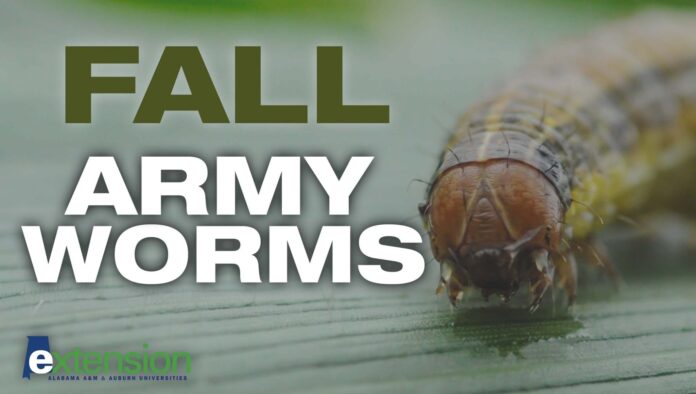AUBURN UNIVERSITY, Ala. — Fall armyworms are plaguing pastures and hayfields in many areas of Alabama. These pests can quickly invade and destroy a stand of healthy forages in a manner of hours. This makes scouting extremely important for producers to be able to treat infestations early before too much damage occurs.
The current situation
Alabama is currently facing a massive outbreak of fall armyworms. While rain patterns may be playing a role in the outbreak, entomologists with the Alabama Cooperative Extension System are certain that recent high temperatures are a factor.
Producers can usually expect to see a new flight of fall armyworms every 30 days. However, the temperatures in the state are speeding up the development of each generation. This is causing flights to occur closer to every 25 days, which leads to more armyworms overlapping and causing more issues.
Scouting, scouting, scouting
When it comes to scouting, time is of the essence. Scott Graham, an Alabama Extension entomologist, said scouting is critical for managing any pests, and fall armyworms are no different. Currently, pasture and forage producers need to be alert and scouting closely.
“These pests are called armyworms for a reason,” Graham said. “They are exceptionally fast and efficient when consuming forages. To scout, I recommend using a sweep net or getting down and looking to see if worms are present in the fields.”
It is best to scout during the cooler parts of the day when the caterpillars are actively feeding. However, producers can scout during the hotter parts of the day by looking for armyworms near the soil surface.
“A lot of times, we don’t notice armyworms until we start seeing birds flocking to fields to eat them,” said Caitlyn Lawton, a graduate research assistant at Auburn University. “With the amount of pressure we are dealing with now, waiting that long can complicate things.”
When scouting, note both the size and number of armyworms. This will greatly affect the needed control strategy. Lawton said catching fall armyworms when they are less than ½ inch long is key for control.
“Fall armyworms are much easier to control when they are smaller,” Lawton said. “Producers can also look for damage the caterpillars cause, which will appear as jagged grass edges.”
Control options
If armyworms are present, quick and efficient action is crucial to controlling them. There are multiple control options for fall armyworms in pastures, including mechanical and chemical options.
“Hayfields can be harvested early, if they are close to harvest, or cattle can be moved onto the field to graze before the armyworms consume it all,” Lawton said.
When it comes to chemical control, the right application largely depends on where it is being used. Chemicals vary in price, residual control and level of rainfastness (the time needed between an application and a period of rain). Graham offers the following recommendations for armyworm control in pastures and hayfields:
- Insect growth regulators. Products that contain diflubenzuron (Dimilin) or methoxyfenozide (Intrepid) are insect growth regulators. They control the pest by disrupting its life cycle. They are best for controlling small caterpillars. Residual control for diflubenzuron products is approximately 10 days. Residual control for methoxyfenozide products is seven days. Both will cease to provide control following rain.
- Pyrethroids. Common pyrethroid products include Mustang Maxx, Karate and Warrior II. These chemicals will provide more immediate knockdown but have shorter residual control. They will also stop providing control after rain.
- If the frequency of rain in the state continues, producers should consider applying products that are more rainfast. Products containing chlorantraniliprole, such as Vantacor and Besiege, are taken up by the plant, so they are still effective after a rain. These products are more expensive, but they offer longer control, up to 21 days at the highest labeled rate.
“If producers do not plan to harvest for another 10 to 14 days and have multiple generations of armyworms, they should consider mixing a pyrethroid and an insect growth regulator or using a diamide,” Graham said.
Whichever chemical you chose, Lawton said it is important to make applications late in the day. This will allow the armyworms to ingest the chemical while they eat overnight. A list of products labeled for pasture and forage armyworm control is available in the Alabama Extension Pastures and Forage Crop IPM Guide.
Potential control issues
There are several hurdles that producers can experience when controlling armyworms. As mentioned above, pyrethroid applications stop working after a rain event. While they are a control option, Graham said producers should use caution.
“We experienced widespread reports of pyrethroid failures across the country in 2021,” Graham said. “So far, that has not been the case this year. However, we have received multiple reports across Alabama of sporadic control this year.”
Depending on the situation, Graham suggests that producers avoid pyrethroids insecticides right now.
“As fall armyworms get larger, they consume more food and most of the more-consistent materials are a little slower to control,” Graham said. “Waiting a few days to evaluate a control failure can be the difference in saving a field or not.”
I have sprayed. Now what?
After making a chemical application, producers must monitor their fields to see how the armyworms are affected. Do not panic if there are not near-immediate results. All chemicals have different modes of actions, and it may take longer for some of them to start working.
There may be some instances where the application does not fully control the infestation, and a second application may be necessary. For example, if there was a rain event and a systemic insecticide was not used, Graham said a second application should be done.
However, it is important to remember that if a spray failure does occur, do not use the same mode of action. For example, if a producer uses a pyrethroid and control was not achieved, they might use a carbaryl product for the second application.
More information
For more information on controlling armyworms, read Control Options for Fall Armyworms or Management of Fall Armyworm in Pastures and Hayfields, both available at www.aces.edu.
Trade and brand names used in this publication are given for information purposes only. No guarantee, endorsement, or discrimination among comparable products is intended or implied by the Alabama Cooperative Extension System.

















